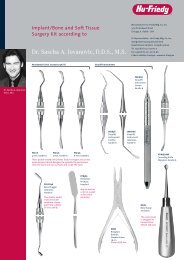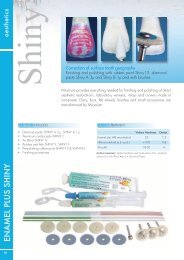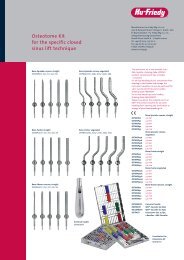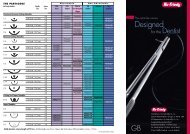Gracey Curettes
Gracey Curettes
Gracey Curettes
- No tags were found...
Create successful ePaper yourself
Turn your PDF publications into a flip-book with our unique Google optimized e-Paper software.
<strong>Gracey</strong> <strong>Curettes</strong><br />
Anterior SG1/2<br />
Posterior SG7/8<br />
Posterior SG11/12<br />
Standard <strong>Gracey</strong> Curette<br />
The <strong>Gracey</strong> curettes combine a unique offset blade with 9 different shank designs to be used on specific tooth<br />
surfaces, thus improving adaptation and deposit removal. Also referred to as Finishing <strong>Gracey</strong> <strong>Curettes</strong>.<br />
SG7/897<br />
Rigid and Extra Rigid <strong>Gracey</strong> Curette<br />
• All designs available with wider taper - increased shank rigidity<br />
• The rigid and extra rigid shank are preferred for heavier calculus removal.<br />
• Although the shank is wider, the blade width is the same as a standard <strong>Gracey</strong>.<br />
SG17/18R9<br />
RIGID<br />
After Five <strong>Gracey</strong> Curette<br />
• Designed for instrumentation in deeper periodontal pockets.<br />
• Elongated terminal shank (3mm) provides better clearance around crowns, and superior access to root<br />
contours and pockets 5mm or more in depth.<br />
• Thinner blade permits easier subgingival insertion.<br />
SRPG11/129
Posterior SG13/14<br />
distal<br />
Posterior SG15/16<br />
mesial<br />
Posterior SG17/18<br />
distal<br />
Mini Five <strong>Gracey</strong> Curette<br />
• Designed with the same elongated terminal shank (3mm) and thinned blades as the<br />
After Five <strong>Gracey</strong> <strong>Curettes</strong>.<br />
• 50% shorter blade for access to smaller roots, narrow pockets, furcations, and<br />
developmental grooves.<br />
Mini Five reaching into a deep<br />
pocket on a narrow root<br />
SAS1/291<br />
Front<br />
NEW!<br />
Micro Mini Five <strong>Gracey</strong> Curette<br />
With ultra slender blades and increased shank rigidity, the Micro Mini Five <strong>Gracey</strong> <strong>Curettes</strong> will enable clinicians<br />
to precisely debride root and tooth surfaces free of all deposits, even in the deepest and most challenging<br />
periodontal pockets.<br />
SMS11/1293<br />
GRACEY INSTRUMENTATION<br />
The blade of a <strong>Gracey</strong> curette is correctly adapted when the<br />
lower cutting edge is against the tooth, and the terminal shank<br />
is parallel to the tooth surface being scaled. Apply lateral<br />
pressure against the tooth (root) and pull upward, maintaining<br />
the parallel shank.<br />
Pull stroke<br />
70°<br />
Lateral pressure<br />
• The blade is offset from the shank at 70°. This creates<br />
one cutting edge which is referred to as the lower edge.<br />
• <strong>Gracey</strong> curettes are used in a set to completely scale the<br />
dentition.
<strong>Gracey</strong> Design Comparisons<br />
Shank Design<br />
and<br />
Diameter<br />
Blade<br />
Length<br />
Blade<br />
Width<br />
Available<br />
Patterns<br />
and<br />
Area of Use<br />
see chart to match color<br />
Anterior<br />
Standard<br />
(Finishing)<br />
Standard<br />
Standard<br />
Standard<br />
1/2, 3/4, 5/6<br />
7/8, 9/10<br />
11/12, 15/16<br />
13/14, 17/18*<br />
Buccal Lingual<br />
Surfaces<br />
Mesial Surfaces<br />
Premolars, Molars<br />
Distal Surfaces<br />
Premolars, Molars<br />
Rigid<br />
After<br />
Five ®✣<br />
Standard<br />
design,<br />
increased shank<br />
diameter<br />
Longer terminal<br />
shank, standard<br />
diameter<br />
Standard<br />
Standard<br />
Standard<br />
Decreased<br />
by 10%<br />
1/2, 3/4, 5/6<br />
7/8, 9/10<br />
11/12, 15/16<br />
13/14, 17/18*<br />
1/2, 3/4, 5/6<br />
7/8<br />
11/12, 15/16<br />
13/14<br />
Rigid<br />
After Five<br />
Longer terminal<br />
shank, increased<br />
diameter<br />
Standard<br />
Decreased<br />
by 10%<br />
1/2, 3/4, 5/6<br />
7/8<br />
11/12, 15/16<br />
13/14<br />
Refer to the chart to match instruments<br />
with area of application by using the<br />
color-coded diagram above.<br />
1/2, 3/4, 5/6<br />
7/8, 9/10<br />
11/12, 15/16<br />
13/14, 17/18*<br />
Mini Five Longer terminal<br />
shank, standard<br />
diameter<br />
Decreased<br />
by 50%<br />
Decreased<br />
by 10%<br />
1/2, 3/4, 5/6<br />
7/8<br />
11/12, 15/16<br />
13/14<br />
Rigid<br />
Mini Five<br />
Micro<br />
Mini Five<br />
Longer terminal<br />
shank, increased<br />
diameter<br />
Longer terminal<br />
shank, increased<br />
diameter<br />
Decreased<br />
by 50%<br />
Decreased<br />
by 50%<br />
compared<br />
to After<br />
Five/Stanard<br />
Decreased<br />
by 10%<br />
Decreased<br />
by 20%<br />
compared<br />
to Mini Five<br />
1/2, 3/4, 5/6<br />
7/8<br />
11/12, 15/16<br />
13/14<br />
1/2<br />
7/8<br />
11/12<br />
13/14<br />
*The 17/18 is a unique pattern, having a longer terminal shank and slightly shorter blade<br />
<strong>Gracey</strong> Tip Comparisons<br />
•——•<br />
•————•<br />
•——•<br />
•——————•<br />
+3 mm<br />
./. 50 %<br />
•—•<br />
•——————•<br />
+3 mm<br />
./. 20 %<br />
• •<br />
•——————•<br />
+3 mm<br />
Standard <strong>Gracey</strong><br />
Curette<br />
After Five Curette<br />
Mini Five<br />
Curette<br />
Micro Mini Five<br />
Curette<br />
Sharpening<br />
The Hu-Friedy Sidekick sharpener is designed for routine maintenance<br />
sharpening of scalers and curettes.<br />
In addition to the Sidekick sharpener, a wide range of manual<br />
sharpening stones are also available.<br />
SDKKIT
Universal <strong>Curettes</strong><br />
Universal Curette<br />
Universal curettes are designed for moderate calculus removal on supragingival and<br />
subgingival tooth surfaces. The blade of a universal curette has a round toe and back,<br />
and two cutting edges for scaling, making it an efficient design for scaling the entire<br />
mouth. Universal curettes are also available with rigid shanks in select patterns for<br />
moderate to heavy calculus removal.<br />
SC4R/4L9<br />
Posterior Universal Instrumentation Sequence<br />
Begin at the distal line angle of the most posterior tooth. Direct the<br />
toe of the blade toward the distal with the terminal shank angled<br />
slightly toward the tooth. Apply strokes from the line angle to the<br />
contact area. Next, turn the toe toward the mesial to scale the<br />
buccal and mesial surfaces. Continue this sequence to complete<br />
the posterior region. Switch ends and repeat from the lingual aspect.<br />
Surfaces toward<br />
Surfaces away<br />
Anterior Universal Instrumentation Sequence<br />
To scale the facial surfaces, place the toe of the blade toward the<br />
proximal surface with the handle parallel to the tooth. Apply strokes<br />
to remove deposits from the centerline of the tooth to the proximal<br />
surface. Work from canine to canine. Switch working ends and<br />
repeat for surfaces away from you. Repeat all of the above for the<br />
lingual surfaces.<br />
Universal Curette Instrumentation<br />
The correct working end for scaling is evident when the toe is<br />
directed interproximally and the terminal shank is parallel to the<br />
tooth. To remove deposits, the cutting edge is applied to the<br />
tooth surface and the facial surface of the blade is tilted toward<br />
the tooth to achieve an approximate 85° angle between the<br />
tooth and blade. Apply lateral pressure against the tooth and<br />
pull upward while maintaining contact with the tooth.<br />
Pull stroke<br />
85°<br />
Lateral<br />
pressure<br />
TIP<br />
When choosing instruments, consider your goals and outcomes.<br />
Pocket depth, tooth anatomy and calculus characteristics will determine<br />
the optimal choice of shank rigidity, blade length, blade thickness, shank<br />
length and bend geometry. Considering these features in instrument<br />
selection will help to work smarter, not harder! Join Friends of Hu-Friedy<br />
(friendsofhufriedy.com) to learn more about these products and other<br />
valuable opportunities.
Sickle Scalers<br />
Sickle Scalers<br />
• Sickle scalers are designed for moderate to heavy deposit removal.<br />
• Specific Sickle scalers are available for anterior or posterior applications.<br />
• They are mainly used to remove supragingival calculus or calculus which is<br />
located just below the gingiva.<br />
SJ34/359<br />
Straight Blade Design<br />
Excellent for broad facial<br />
and lingual surfaces and<br />
can also be used<br />
interproximally.<br />
SH6/79<br />
Curved Blade Design<br />
Excellent for removal of<br />
interproximal deposits.<br />
Sickle Scaler Instrumentation<br />
To remove calculus, adapt the tip 1/3 of the cutting edge against<br />
the tooth, under the deposit. Tilt the facial surface of the blade<br />
toward the tooth to achieve an approximate 85°angle between the<br />
tooth and the blade. Apply lateral pressure against the tooth and<br />
pull the scaler firmly upward to dislodge the deposit. Both sides<br />
(cutting edges) of the blade can be used for mesial or distal, facial<br />
or lingual application. The instrumentation sequence is the same<br />
as for universal curettes, using anterior and posterior designs.<br />
Pull stroke<br />
85°<br />
Lateral<br />
pressure<br />
Hu-Friedy Mfg. Co., Inc.<br />
3232 N. Rockwell St.<br />
Chicago, IL 60618<br />
1-800-HU-FRIEDY<br />
www.hu-friedy.com<br />
Hu-Friedy Mfg. B.V.<br />
European Headquarters &<br />
Customer Care Department<br />
P.O. Box 29025<br />
NL-3001GA Rotterdam<br />
+800 48 37 43 39<br />
www.hu-friedy.eu<br />
©2008 Hu-Friedy Mfg. Co., Inc. All Rights Reserved. HU-FRIEDY, the Hu-Friedy oval logo, EverEdge, After Five and Mini Five are trademarks of Hu-Friedy Mfg. Co., Inc., registered in the<br />
U.S.Pat.&TM.Off.<br />
HF-567GB
Clinical Application Guide<br />
SCALERS and CURETTES






